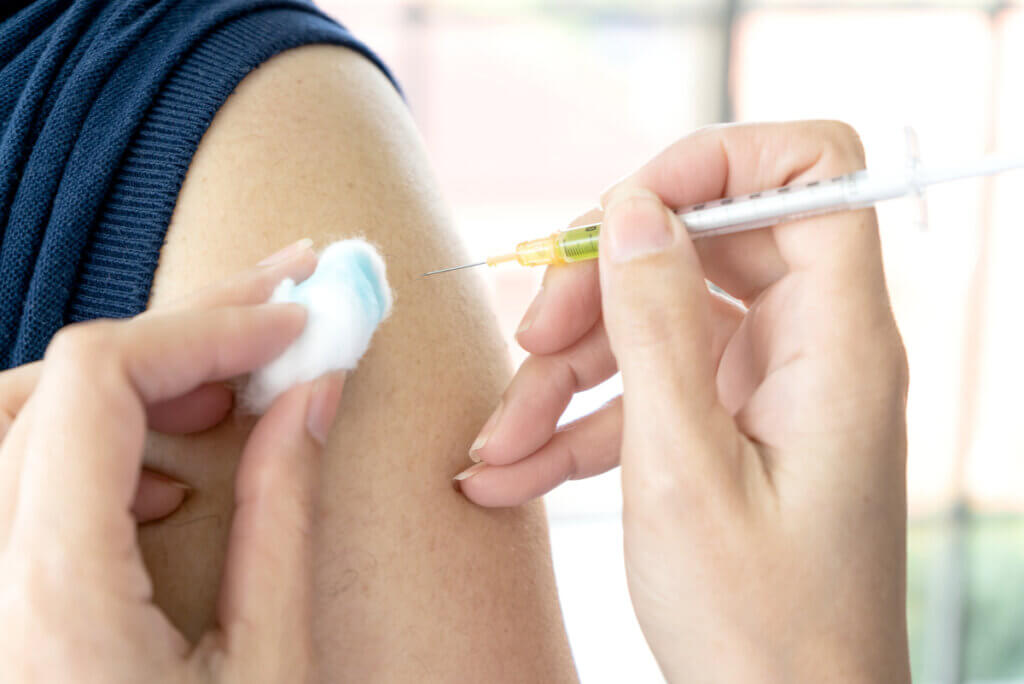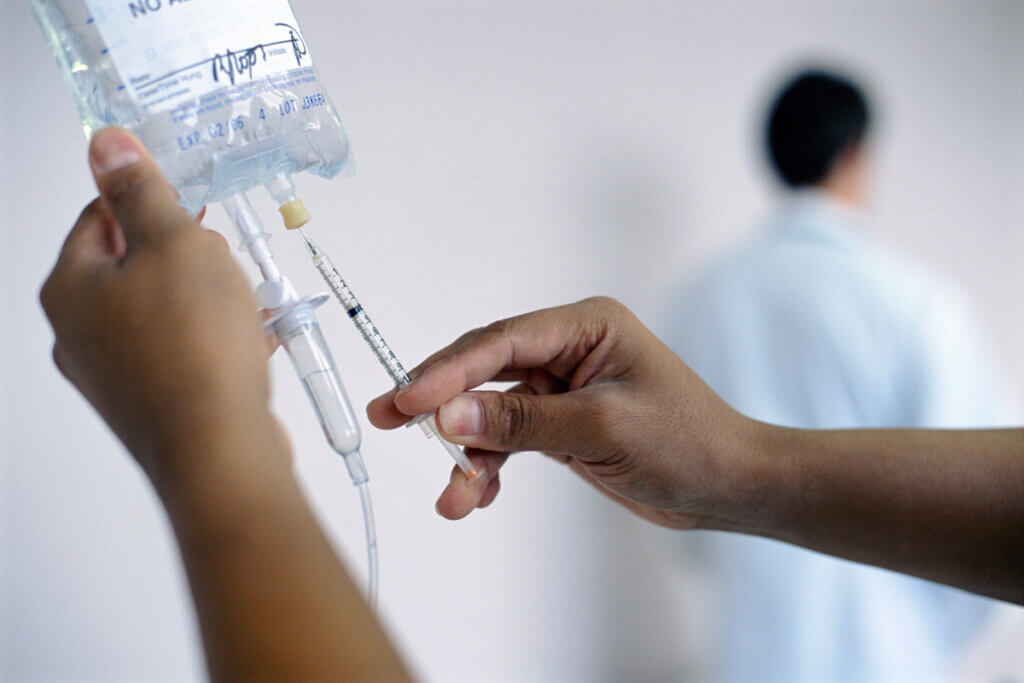The Difference Between Vaccines and Antidotes

A large number of different substances are used in the treatment of diseases. Among the compounds used, drugs, vaccines and antidotes stand out. In general, people confuse vaccines with antidotes, even though their differences are very significant.
The human body is in a dynamic balance with the environment and is constantly adapting for its survival. People are exposed to microorganisms, viruses, and toxins. All of these substances must be neutralized or removed to ensure good health.
Antidotes and vaccines are some of the tools used to neutralize harmful compounds in the human body. These substances have many similarities to each other, although they have several differences in their structure, mechanism of action, and uses.
1. Chemical structure
The chemical structure of vaccines and antidotes is one of the main differences between the two products. It determines both the mechanism of action and the therapeutic uses. Vaccines generally consist of antigens, adjuvants, and stabilizers.
Antigens are small molecules foreign to the body, obtained from a dead or weak germ. These molecules are extracted from bacteria or viruses that are processed in specialized laboratories. Today there are many known antigens, such as hepatitis viruses, measles, meningococcus, and pneumococcus, and adjuvants and stabilizers are designed to ensure the durability and efficacy of vaccines.
On the other hand, antidotes include a wide variety of chemicals of animal, plant, or synthetic origin. Some antidotes are synthesized from toxic products in order to neutralize them.

2. Mechanism of action
Vaccines and antidotes have the common goal of protecting the human body from harmful agents. However, they follow different paths to achieve this task. On the one hand, vaccination seeks to immunize people against infectious germs, preventing these from invading the tissues or causing a more serious condition.
The human body responds to the vaccine by strengthening its natural defenses. To do this, it increases the production of antibodies responsible for identifying and destroying the specific germs contained in the vaccine. In this way, the immune system will react immediately to a possible infection, preventing the progression of the disease.
Some research claims that antidotes are intended to neutralize and counteract the effects of a poison, toxin, or chemical that has entered the body. Today, activated charcoal is considered the universal antidote.
Antidotes act directly on the harmful agent, blocking its effects. They’re capable of altering and even destroying the chemical structure of the poison. Some antidotes trap the harmful substance and prevent its absorption by the tissues.
3. Uses
The basic function of vaccines is to prevent certain infectious diseases of viral or bacterial origin. In addition, they also act by reducing the risk of suffering a more severe clinical picture.
Among the diseases that can be prevented with a vaccine are the following:
- Rotavirus
- Rubella and measles
- Yellow fever
- Hepatitis A and B
- Poliomyelitis
- Whooping cough
- Diphtheria and tetanus
On the other hand, antidotes are useful in the treatment of poisonings by chemical compounds, drugs, or animal poisons. In this way, they reduce the adverse effects of these substances on the body.
Some of the poisonings treated with antidotes are the following:
- Scorpion venom
- Snake toxins
- Pesticides and pesticides
- Opioids and benzodiazepines
- Antidepressants
- Heavy metals
In fact, some studies certify that N-acetylcysteine is one of the most used antidotes in poisoning by hepatotoxic agents. In this regard, vaccines and antidotes have very different applications.
4. Types
The great variety of vaccines and antidotes is one of the biggest differences between the two substances. At present, 4 types of vaccines are available according to the composition and the type of expected response.
Among the main presentations are the following:
- Live attenuated vaccines: These are vaccines that contain a weakened form of the germ responsible for the disease. Among this group are the triple viral vaccine and the vaccine against chickenpox.
- Inactivated: These use an inactivated or dead version of a virus or bacteria.
- Subunit or recombinant vaccines: These use specific fragments of the germ, such as proteins or sugars. The hepatitis B vaccine uses this technology.
- Toxoids: These contain the toxins released by the infectious microorganism. For this reason, the immune response will be aimed at neutralizing the toxin and not the germ. Among this group is the vaccine for tetanus and diphtheria.
On the other hand, antidotes include a varied repertoire of compounds that can be classified according to the mechanism they fulfill within the body:
- Competitive: These compete with the toxic agent for their site of activity. Among them are flumazenil, oxygen, physostigmine, and atropine.
- Blockers: These substances inhibit the action of the poison on the body. Silibinin and fomepizole are some of the more common forms of this type.
- Restorers: These allow the body to recover the internal balance and the concentration of metabolites essential for life. Among this group, we can include glucose, glucagon, and pyridoxine.
- Chelators: These bind to the harmful agent and prevent its action, favoring elimination via the kidneys or intestines. Some of the most used are dimercaprol, antivenom, and botulism antitoxin.
- Reducers: These change the composition and chemical structure of the toxic substance. A clear example is ascorbic acid and methylene blue.

Two substances that can save lives
Despite their differences, antidotes and vaccines are substances responsible for saving millions of lives around the world. For this reason, people must know what the purposes of these products are and when they should be administered. Applying them at the right time could make the difference between life and death.
At the same time, if you have any questions or concerns about these substances, don’t hesitate to seek medical attention. Only health professionals are trained to assess a person’s general condition and offer the best therapeutic tools.
A large number of different substances are used in the treatment of diseases. Among the compounds used, drugs, vaccines and antidotes stand out. In general, people confuse vaccines with antidotes, even though their differences are very significant.
The human body is in a dynamic balance with the environment and is constantly adapting for its survival. People are exposed to microorganisms, viruses, and toxins. All of these substances must be neutralized or removed to ensure good health.
Antidotes and vaccines are some of the tools used to neutralize harmful compounds in the human body. These substances have many similarities to each other, although they have several differences in their structure, mechanism of action, and uses.
1. Chemical structure
The chemical structure of vaccines and antidotes is one of the main differences between the two products. It determines both the mechanism of action and the therapeutic uses. Vaccines generally consist of antigens, adjuvants, and stabilizers.
Antigens are small molecules foreign to the body, obtained from a dead or weak germ. These molecules are extracted from bacteria or viruses that are processed in specialized laboratories. Today there are many known antigens, such as hepatitis viruses, measles, meningococcus, and pneumococcus, and adjuvants and stabilizers are designed to ensure the durability and efficacy of vaccines.
On the other hand, antidotes include a wide variety of chemicals of animal, plant, or synthetic origin. Some antidotes are synthesized from toxic products in order to neutralize them.

2. Mechanism of action
Vaccines and antidotes have the common goal of protecting the human body from harmful agents. However, they follow different paths to achieve this task. On the one hand, vaccination seeks to immunize people against infectious germs, preventing these from invading the tissues or causing a more serious condition.
The human body responds to the vaccine by strengthening its natural defenses. To do this, it increases the production of antibodies responsible for identifying and destroying the specific germs contained in the vaccine. In this way, the immune system will react immediately to a possible infection, preventing the progression of the disease.
Some research claims that antidotes are intended to neutralize and counteract the effects of a poison, toxin, or chemical that has entered the body. Today, activated charcoal is considered the universal antidote.
Antidotes act directly on the harmful agent, blocking its effects. They’re capable of altering and even destroying the chemical structure of the poison. Some antidotes trap the harmful substance and prevent its absorption by the tissues.
3. Uses
The basic function of vaccines is to prevent certain infectious diseases of viral or bacterial origin. In addition, they also act by reducing the risk of suffering a more severe clinical picture.
Among the diseases that can be prevented with a vaccine are the following:
- Rotavirus
- Rubella and measles
- Yellow fever
- Hepatitis A and B
- Poliomyelitis
- Whooping cough
- Diphtheria and tetanus
On the other hand, antidotes are useful in the treatment of poisonings by chemical compounds, drugs, or animal poisons. In this way, they reduce the adverse effects of these substances on the body.
Some of the poisonings treated with antidotes are the following:
- Scorpion venom
- Snake toxins
- Pesticides and pesticides
- Opioids and benzodiazepines
- Antidepressants
- Heavy metals
In fact, some studies certify that N-acetylcysteine is one of the most used antidotes in poisoning by hepatotoxic agents. In this regard, vaccines and antidotes have very different applications.
4. Types
The great variety of vaccines and antidotes is one of the biggest differences between the two substances. At present, 4 types of vaccines are available according to the composition and the type of expected response.
Among the main presentations are the following:
- Live attenuated vaccines: These are vaccines that contain a weakened form of the germ responsible for the disease. Among this group are the triple viral vaccine and the vaccine against chickenpox.
- Inactivated: These use an inactivated or dead version of a virus or bacteria.
- Subunit or recombinant vaccines: These use specific fragments of the germ, such as proteins or sugars. The hepatitis B vaccine uses this technology.
- Toxoids: These contain the toxins released by the infectious microorganism. For this reason, the immune response will be aimed at neutralizing the toxin and not the germ. Among this group is the vaccine for tetanus and diphtheria.
On the other hand, antidotes include a varied repertoire of compounds that can be classified according to the mechanism they fulfill within the body:
- Competitive: These compete with the toxic agent for their site of activity. Among them are flumazenil, oxygen, physostigmine, and atropine.
- Blockers: These substances inhibit the action of the poison on the body. Silibinin and fomepizole are some of the more common forms of this type.
- Restorers: These allow the body to recover the internal balance and the concentration of metabolites essential for life. Among this group, we can include glucose, glucagon, and pyridoxine.
- Chelators: These bind to the harmful agent and prevent its action, favoring elimination via the kidneys or intestines. Some of the most used are dimercaprol, antivenom, and botulism antitoxin.
- Reducers: These change the composition and chemical structure of the toxic substance. A clear example is ascorbic acid and methylene blue.

Two substances that can save lives
Despite their differences, antidotes and vaccines are substances responsible for saving millions of lives around the world. For this reason, people must know what the purposes of these products are and when they should be administered. Applying them at the right time could make the difference between life and death.
At the same time, if you have any questions or concerns about these substances, don’t hesitate to seek medical attention. Only health professionals are trained to assess a person’s general condition and offer the best therapeutic tools.
- Collado Coello A, González G, Gómez Carril M. Los antídotos en la lucha contra las intoxicaciones. Rev Cubana Farm. 2004 Ago ; 38( 2 ): 1-1.
- Ramírez Sánchez M, Pascuzzo Lima C, Bastidas O. Tratamiento de intoxicaciones por compuestos hepatotóxicos: Uso de la N-acetilcisteina y las Carboximetilcisteina. Arch Venez Puer Ped. 2009 Jun ; 72( 2 ): 68-72.
- Valenzuela M. Importancia de las vacunas en salud pública: hitos y nuevos desafíos. Revista Médica Clínica Las Condes. 2020;31(3):233-239.
- Nogué-Xarau S, Aguilar-Salmerón R. Antidotes: the mortar that binds pharmacologists, emergency physicians, and toxicologists together. Farm Hosp. 2019 Jul 1;43(4):117-118.
- Garcés-Sánchez M, Renales-Toboso M, Bóveda-García M, Díez-Domingo J. Vacuna triple vírica. Resurgimiento del sarampión en Europa [Measles, mumps, and rubella vaccine. Resurgence of measles in Europe]. Enferm Infecc Microbiol Clin. 2015 Dec;33(10):673-8.
- Nogué S, Miró O, Aguilar R. Antídotos y servicios de urgencias [Emergency antidotes and services]. An Pediatr (Barc). 2015 May;82(5):e260-1.
Este texto se ofrece únicamente con propósitos informativos y no reemplaza la consulta con un profesional. Ante dudas, consulta a tu especialista.







